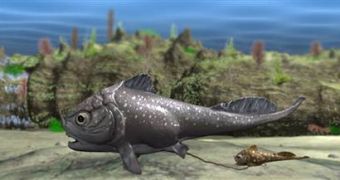Scientists have recently found the oldest known fossil that indicates that reproduction through birth was encountered in vertebrate animals as early as 380 million years ago. The fossil belongs to an armored fish female that was about to give birth, but it perished and got fossilized along with the embryo inside it. The previous oldest evidence of the presence of reproduction through birth was found in a fossil dated some 180 million years ago.
The new finding also supports the idea that vertebrates inherited internal fertilization from primitive fish.
"When I first saw the embryo inside the mother fish, my jaw dropped. It dawned on me after studying the specimen that this was the earliest evidence of vertebrates having sex by copulation - not just spawning in water, but sex that was fun. The new species called Materpiscis attenboroughi is a type of placoderm, a group of extinct, armored fish with bone-crushing jaws that ruled the seas throughout the Devonian Period, from 417 million to 354 million years ago", said paleontologist John Long from Museum Victoria.
The remains were found during an expedition funded by the Australian Research Council in the Gogo Formation, Western Australian, a region known to harbor well-preserved fish fossils, area that at the time when Materpiscis lived was a tropical reef filled with life. The Placoderm embryo measured about 25 centimeters in length and was found in what appears to be the uterus, making for about 25 percent of the body mass of the female.
"The large size of the embryo relative to the mother indicates that the young of this fish were born well-formed, a strategy that may have evolved to counter predation from other larger fishes", said Steven Salisbury from the University of Queensland.
Once the pregnant Materpiscis was found, Long decided to re-analyze a previously found Placoderm living at about the same time as the Materpiscis and discovered that there might have been be three embryos developing inside its body. The reproductive biology of the Placoderms appears to be rather similar to that of modern sharks, meaning it was highly advanced at the moment.

 14 DAY TRIAL //
14 DAY TRIAL //